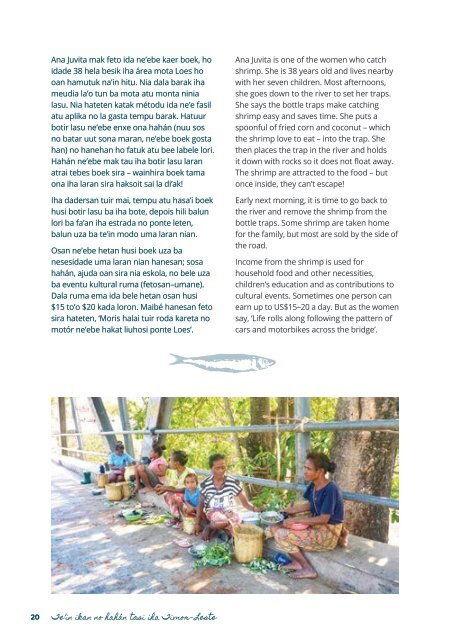Create successful ePaper yourself
Turn your PDF publications into a flip-book with our unique Google optimized e-Paper software.
Ana Juvita mak feto ida ne’ebe kaer boek, ho<br />
idade 38 hela besik iha área mota Loes ho<br />
oan hamutuk na’in hitu. Nia dala barak iha<br />
meudia la’o tun ba mota atu monta ninia<br />
lasu. Nia hateten katak métodu ida ne’e fasil<br />
atu aplika no la gasta tempu barak. Hatuur<br />
botir lasu ne’ebe enxe ona hahán (nuu sos<br />
no batar uut sona maran, ne’ebe boek gosta<br />
han) no hanehan ho fatuk atu bee labele lori.<br />
Hahán ne’ebe mak tau iha botir lasu laran<br />
atrai tebes boek sira – wainhira boek tama<br />
ona iha laran sira haksoit sai la di’ak!<br />
Iha dadersan tuir mai, tempu atu hasa’i boek<br />
husi botir lasu ba iha bote, depois hili balun<br />
lori ba fa’an iha estrada no ponte leten,<br />
balun uza ba te’in modo uma laran nian.<br />
Osan ne’ebe hetan husi boek uza ba<br />
nesesidade uma laran nian hanesan; sosa<br />
hahán, ajuda oan sira nia eskola, no bele uza<br />
ba eventu kultural ruma (fetosan–umane).<br />
Dala ruma ema ida bele hetan osan husi<br />
$15 to’o $20 kada loron. Maibé hanesan feto<br />
sira hateten, ‘Moris halai tuir roda kareta no<br />
motór ne’ebe hakat liuhosi ponte Loes’.<br />
Ana Juvita is one of the women who catch<br />
shrimp. She is 38 years old and lives nearby<br />
with her seven children. Most afternoons,<br />
she goes down to the river to set her traps.<br />
She says the bottle traps make catching<br />
shrimp easy and saves time. She puts a<br />
spoonful of fried corn and coconut – which<br />
the shrimp love to eat – into the trap. She<br />
then places the trap in the river and holds<br />
it down with rocks so it does not float away.<br />
The shrimp are attracted to the food – but<br />
once inside, they can’t escape!<br />
Early next morning, it is time to go back to<br />
the river and remove the shrimp from the<br />
bottle traps. Some shrimp are taken home<br />
for the family, but most are sold by the side of<br />
the road.<br />
Income from the shrimp is used for<br />
household food and other necessities,<br />
children’s education and as contributions to<br />
cultural events. Sometimes one person can<br />
earn up to US$15–20 a day. But as the women<br />
say, ‘Life rolls along following the pattern of<br />
cars and motorbikes across the bridge’.<br />
20<br />
Te’in ikan no hahán tasi iha Timor - <strong>Leste</strong>

















